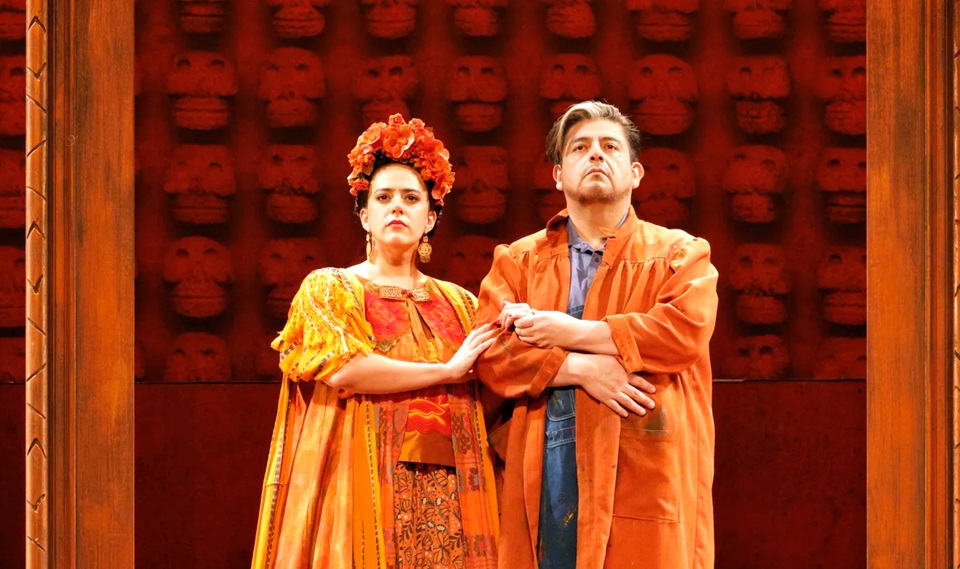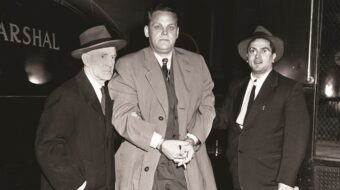
LOS ANGELES — If ever there was a couple absolutely ideal for immortalization in the musical medium of opera, it’s Frida Kahlo and Diego Rivera. They are indelibly iconic as Mexico’s premier artists, communists, and legendary lovers. Their romance and marriages were marked by intense ardor and infidelity, with equally passionate politics, befriending the beleaguered co-leader of the Russian Revolution after Leon Trotsky was exiled from the Soviet Union and sought refuge in Mexico. Of course, Rivera’s masterful murals and Kahlo’s expressive canvases are the aesthetic foundations of their lasting renown.
Latin Grammy winner composer Gabriela Lena Frank and Pulitzer Prize winner librettist Nilo Cruz have teamed up to pay homage to the on-again, off-again husband and wife painters with the 2022 opera El último sueño de Frida y Diego (The Last Dream of Frida and Diego). LA Opera’s production has a heavy infusion of Hispanic talent: The composer is of mixed heritage that includes Peruvian and Jewish lineage (as Kahlo herself was part Jewish), while the librettist was born in Cuba. Frank and Cruz’s almost two-and-a-half-hour, two-act opera eschews the leftwing couple’s famed politics and focuses instead on the lasting loving bond of what some consider to be one of the great romantic couplings of the ages, and the influence of Mexican culture on Frida and Diego.
In LA Opera’s company premiere of El último sueño (which debuted in 2022 at San Diego Opera), the curtains cleverly seem to be inside of a golden picture frame. When the curtains lift, a tableau of a cemetery, presumably near Mexico City, appears on the stage of the Dorothy Chandler Pavilion, brilliantly rendered by Mexican scenic designer Jorge Ballina, and enhanced with spectral lighting by Mexican lighting designer Victor Zapatero. It is the Día de los Muertos (Day of the Dead), November 2, 1957, and the music and tonality of the ochre-hued sets and costumes (by Mexican costume designer Eloise Kazan) are appropriately somber. The sound emanating from the orchestra pit, presided over by Colombian Lisa González-Granados, LA Opera’s resident conductor, is heavy on percussion and chimes.

A forlorn Diego Rivera (Mexican baritone Alfredo Daza) enters and implores his dearly departed wife to come back to the aging, ailing, alone muralist. La Catrina, Keeper of the Dead (Puerto Rican soprano Ana María Martínez), who poses as a flower seller to Diego in the graveyard, travels to the Aztec underworld, Mictlán, to summon the three-years-dead Frida (Argentine mezzo-soprano Daniela Mack) back to the land of the living. In a visually stunning mise-en-scène, parts of the set arise and seem to float, enhancing the unearthly sensibility of the realms of the dead being depicted. Once Catrina sheds her earthly apparel and assumes her otherworldly identity, her outrageously eye-popping ghostly costume deserves to be remembered at awards time.
For her part, the much-afflicted Kahlo, who’d suffered so much while alive, is conflicted by the notion of returning to life, bemoaning the “two accidents” she’d suffered during her lifetime: Being hit by a trolley while a teenager—which permanently impacted the health of this woman who died long before her time at only 47)—and meeting Diego Rivera. Theirs was an impassioned relationship, but also an extremely mercurial, turbulent, turbocharged one. They may have loved each other deeply, even madly, but they were both famously unfaithful. Diego dallied with, among others, Frida’s sister, and the reputedly bisexual Kahlo—as depicted in Salma Hayek’s superb 2002 film Frida—enjoyed peccadilloes with Trotsky, as well as other women.
Reluctant to come back to life and possibly re-experience the crippling pain she’d endured while amongst us mere mortals, what presumably wins her over to a brief sojourn back to the land of the living is that her nonetheless beloved Diego is suffering. He misses and needs her. Plus, she yearns for art! Act II opens with another visually arresting tableau—Rivera’s Georges Seurat-inspired mural Dream of a Sunday Afternoon in Alameda Park stretches across the stage with live performers striking the poses in the painting that a listless Diego, clad in paint-splattered overalls and perched atop scaffolding, is attempting to paint. He is listless until Frida appears, and they enter the mural together.
Diego takes Frida to Casa Azul (the Blue House), her home and studio. In a series of frames suspended from the ceiling, performers strike poses derived from Frida’s oils, which often expressed her pain and suffering. At one point the wife wryly tells her philandering husband: “All the hurt I painted instead of killing you.” The lovers affectionately call each other by their nicknames: “Palomita” or Little Dove, is what Diego dubs Frida, who refers to her older, overweight partner as “Little Toad.” (The cremated Kahlo’s ashes rest, amusingly, not in a cemetery, but inside a pre-Columbian urn shaped like a toad at Casa Azul.)
There is a touching yet droll scene when Frida, who’d had one limb amputated, once brought back to life, lifts her skirt to make sure she has two legs and feet and, when finding she does, performs a lively dance. Rivera may have painted frescoes frozen in time, but Mexican choreographer Ruby Tagle Willingham’s dances are full of movement.

Various scenes during the opera present a panoply and pageant of the Mexican history that imbued these artists and their work: Indigenous Aztecs, conquistadors, missionaries, campesinos, Spaniards, etc. There are serapes and sombreros galore amidst the colorful cast, making for some very vibrant scenic tableaux to delight the orbs—as is only natural for a production about painters—adeptly helmed by Mexican director Lorena Maza in her LA Opera debut.
I’d be remiss not to mention the character Leonardo (countertenor Key’mon W. Murrah), who cross-dresses as Greta Garbo, and like Frida briefly leaves the land of the dead for the realm of the living, in Garbo garb. Along with chorus director Jeremy Frank, Murrah is one of the few major cast and crew members of El último sueño de Frida y Diego who is not Latino. It is also noteworthy that the lyrics are sung in Spanish (with English supertitles), not the canon’s more common Italian, French, or German. And for the first time that I can recall, the program is at least in part in both English and Spanish.
Composer Gabriela Lena Frank’s work includes many large pieces for orchestra and voice. This is her first opera. Cuban-American librettist Nilo Cruz, who migrated from Cuba to Miami’s “Little Havana” in 1970, is a prolific playwright, best known for Anna in the Tropics, winner of the 2003 Pulitzer Prize for drama and a Tony Award nominee.
El último sueño de Frida y Diego is a moving, musical meditation on death, focusing on the love and artistry of the immortal title characters. Anyone interested in Kahlo and Rivera should, by all and any means, see it. Some members of the audience were adorned in vivid fashions evoking Frida’s couture. But Diego and Frida minus their revolutionary idealism, which animated them in their artistry and activism, are, well, similar to Frida after her amputation. It’s like a stack of pancakes without the syrup. I actually think that “the last dream” of these committed communists was a worldwide, socialist revolution. So, shorn of their politics, by ignoring this essential aspect of their beings, something vital is missing from an otherwise visually compelling, operatic rendition of their endless love story.
El último sueño de Frida y Diego is being performed Thurs., Nov. 30, Weds., Dec. 6, and Sat., Dec. 9 at 7:30 p.m., plus on Sun., Dec. 3 at 2:00 p.m. at the Dorothy Chandler Pavilion, 135 N. Grand Ave., Los Angeles 90012. For tickets, see here; or call (213) 972-8001.
We hope you appreciated this article. At People’s World, we believe news and information should be free and accessible to all, but we need your help. Our journalism is free of corporate influence and paywalls because we are totally reader-supported. Only you, our readers and supporters, make this possible. If you enjoy reading People’s World and the stories we bring you, please support our work by donating or becoming a monthly sustainer today. Thank you!












Comments